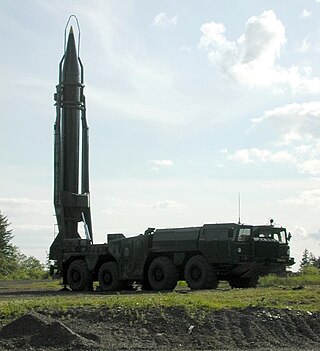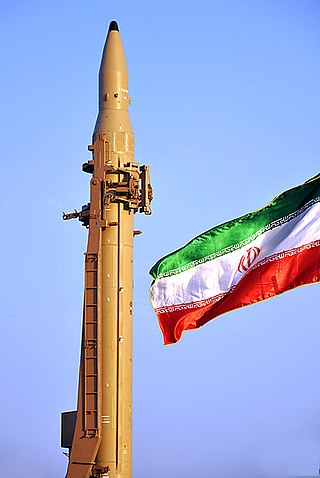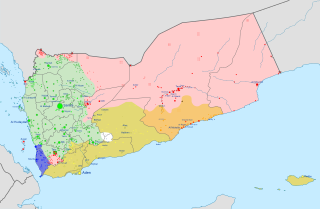Related Research Articles

The Houthi movement, officially known as Ansar Allah, is a Shia Islamist political and military organization that emerged from Yemen in the 1990s. It is predominantly made up of Zaidi Shias, with their namesake leadership being drawn largely from the Houthi tribe.

A Scud missile is one of a series of tactical ballistic missiles developed by the Soviet Union during the Cold War. It was exported widely to both Second and Third World countries. The term comes from the NATO reporting name attached to the missile by Western intelligence agencies. The Russian names for the missile are the R-11, and the R-17Elbrus. The name Scud has been widely used to refer to these missiles and the wide variety of derivative variants developed in other countries based on the Soviet design.

The Qiam 1 is a short-range ballistic missile designed and built by Iran. It was developed from the Iranian Shahab-2, a licensed copy of the North Korean Hwasong-6, all of which are versions of the Soviet Scud-C missile. The Qiam 1 entered service in 2010, with a range of 800 km (500 mi) and 100 m (330 ft) (CEP) accuracy.
The Ya-Ali is an air-launched cruise missile (ALCM) built by Iran. The missile was first unveiled on 11 May 2014 when Iranian leader Grand Ayatollah Ali Khamenei visited the Aerospace Force of the Army of the Guardians of the Islamic Revolution. According to Janes Defence, the missile has a jet engine inlet and possibly uses a version of the Toloue-4 turbojet or different Toloue 10 or 13 engines Iran produces for its longer-range anti-ship missiles and it is reported to have a range of 700 km. On February 7, 2015, Iran's Deputy Defense Minister Mohammad Eslami announced that the missile could previously be launched from only Mirage type fighter planes but it can now be launched from every fighter plane that Iran owns. It is named after a Shi'i religious expression beseeching imam Ali. As an ALCM, the Ya-Ali is distinct from the ground launched cruise missiles (GLCMs) in the Houthi inventory. According to Jane's Defense Weekly, the Houthis may have used a Quds 1 GLCM in the Abha International Airport attack on 12 June 2019. This airport in southwestern Saudi Arabia is less than 200 km from the Yemeni border. The Iranian Ya-Ali has a much longer range due to being imparted with much more kinetic and potential energy when released from a fighter aircraft such as the Mirage type. The Houthis have no fighter aircraft in their inventory.

The Yemeni civil war is an ongoing multilateral civil war that began in late 2014 mainly between the Rashad al-Alimi-led Presidential Leadership Council and the Mahdi al-Mashat-led Supreme Political Council, along with their supporters and allies. Both claim to constitute the official government of Yemen.

On 26 March 2015, Saudi Arabia, leading a coalition of nine countries from West Asia and North Africa, launched a military intervention in Yemen at the request of Yemeni president Abdrabbuh Mansur Hadi, who had been ousted from the capital, Sanaa, in September 2014 by Houthi insurgents during the Yemeni Civil War. Efforts by the United Nations to facilitate a power sharing arrangement under a new transitional government collapsed, leading to escalating conflict between government forces, Houthi rebels, and other armed groups, which culminated in Hadi fleeing to Saudi Arabia shortly before it began military operations in the country.

The Houthi–Saudi Arabian conflict is an ongoing armed conflict between the Royal Saudi Armed Forces and Iran-backed Yemeni Houthi forces that has been taking place in the Arabian Peninsula, including the southern Saudi regions of Asir, Jizan, and Najran, and northern Yemeni governorates of Saada, Al Jawf, and Hajjah, since the onset of the Saudi Arabian-led intervention in Yemen in 2015.
The following is a timeline of the Yemeni civil war, which began in September 2014.
The Burkan-2H, or Volcano-2H is a mobile short-range ballistic missile used by the Houthis militants in Yemen. The Volcano H-2 was first launched in July 2017. It is related to the Scud missile family.
The Burkan-1 or Volcano-1 is a mobile short-range ballistic missile used by the Houthis in Yemen. It is related to the Scud missile family.
The Badr-1 210 mm is a Yemeni military, self-propelled, multiple rocket launcher; a type of rocket artillery, used by Houthis. It features a twin tube launcher mounted on a 6×6 truck.
The Abha International Airport attacks were cruise missile attacks carried out by the Yemeni Houthi rebels which occurred in June 2019. The attack targeted the arrivals hall of Abha International Airport in southwestern Saudi Arabia and killed one civilian and injured 47 others.

On 14 September 2019, drones were used to attack oil processing facilities at Abqaiq and Khurais (خريص) in eastern Saudi Arabia. The facilities were operated by Saudi Aramco, the country's state-owned oil company. The Houthi movement in Yemen claimed responsibility, tying it to events surrounding the Saudi intervention in the Yemeni Civil War and stating they used ten drones in the attack launched from Yemen, south of the facilities. Saudi Arabian officials said that many more drones and cruise missiles were used for the attack and originated from the north and east, and that they were of Iranian manufacture. The United States and Saudi Arabia have stated that Iran was behind the attack while France, Germany, and the United Kingdom jointly stated Iran bears responsibility for it. Iran has denied any involvement. The situation exacerbated the 2019 Persian Gulf crisis.
The 2020 Riyadh drone and missile attack was a cruise missile and drone attack carried out by the Yemeni Houthi rebels which occurred on 23 June 2020. The attack, according to the Houthis, targeted the King Khalid Airport and the Defense Ministry headquarters in Saudi Arabia's capital of Riyadh.
On 30 December 2020, a plane carrying members of the recently formed Yemeni government landed at Aden International Airport in the southwest of Yemen. As passengers disembarked, there were explosions and gunfire, leaving 28 people dead and 107 others injured. None of the passengers were hurt in the attack and the Yemeni cabinet members were quickly transported to Mashiq Palace for safety.
Events in the year 2021 in Saudi Arabia.

The Battle of Marib is an ongoing battle that began in February 2021 following the advance of the Houthis towards the city of Marib, the capital of Marib Governorate in Yemen controlled by the Cabinet of Yemen.
The 2022 Abu Dhabi attack was an attack against three oil tanker trucks and an under construction airport extension infrastructure in Abu Dhabi, United Arab Emirates conducted by the Houthi movement using drones and missiles. Although several missiles and drones were intercepted, 3 civilians were killed and 6 were injured by a drone attack.
Events in the year 2022 in Saudi Arabia.
References
- ↑ "Saudi Arabia says 1 person killed in ballistic missile attack on Riyadh by Yemen rebels". The Washington Times. Retrieved 13 April 2021.
- ↑ Scarsi, Alice (28 March 2018). "Middle East Crisis: Saudi Arabia bombarded with seven missiles over Riyadh".
- ↑ Lewis, Jeffrey (28 March 2018). "Patriot Missiles Are Made in America and Fail Everywhere". Foreign Policy .
- ↑ "UN condemns Al Houthi missile attacks on Saudi Arabia". Agence France-Presse. 29 March 2018.
- ↑ Rashad, Marwa; Dadouch, Sarah; al-Ansi, Abdulrahman (28 March 2018). "Barrage of missiles on Saudi Arabia ramps up Yemen war". Reuters.
- ↑ "Saudi Arabia says Yemeni rebels fired ballistic missiles, killing 1 in Riyadh". www.cbsnews.com. Retrieved 13 April 2021.